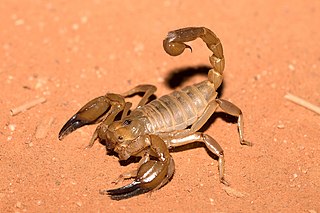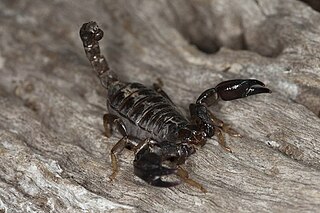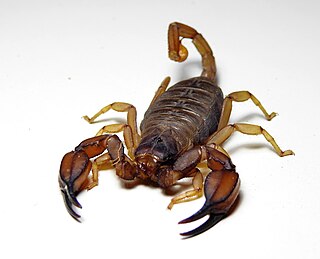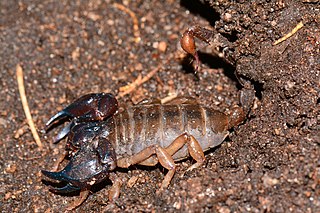
Scorpions are predatory arachnids of the order Scorpiones. They have eight legs and are easily recognized by a pair of grasping pincers and a narrow, segmented tail, often carried in a characteristic forward curve over the back and always ending with a stinger. The evolutionary history of scorpions goes back 435 million years. They mainly live in deserts but have adapted to a wide range of environmental conditions, and can be found on all continents except Antarctica. There are over 2,500 described species, with 22 extant (living) families recognized to date. Their taxonomy is being revised to account for 21st-century genomic studies.

The Namaqua chameleon is a ground-living lizard found in the western desert regions of Namibia, South Africa and southern Angola.

The Ooldea dunnart, also called Troughton's dunnart after the person who found the species, is an Australian marsupial similar to the hairy-footed dunnart. It is greyish-yellow on its upper body and white on the underside with dark patches on its crown, forehead and in front of the eyes, and a pink thinly furred carrot-shaped tail. Its total length is 11.5–17.3 cm (4.5–6.8 in); its average body length is 5.5–8 cm (2.2–3.1 in) with a tail of 6–9.3 cm (2.4–3.7 in). Its ear length is 14–17 mm (0.55–0.67 in). It weighs between 10 and 18 g.

The sandy inland mouse is a species of rodent in the family Muridae. Also known as the Hermannsburg (Mission) false-mouse or Hermannsburg mouse, it is endemic to Australia and found widely yet sparsely through arid and semi-arid areas.

Urodacus is a genus of scorpion belonging to the family Urodacidae. It was described by German naturalist Wilhelm Peters in 1861. The type species is U. novaehollandiae. Its species are native to Australia, and dig burrows. The genus was placed in its own family in 2000. Before this, the group had been a subfamily Urodacinae within the family Scorpionidae.

Urodacus manicatus, commonly known as the black rock scorpion, is a species of scorpion belonging to the family Urodacidae. It is native to eastern Australia.

Urodacus elongatus, commonly known as the Flinders Range scorpion, is a species of scorpion belonging to the family Urodacidae. They are endemic to the Flinders Ranges of South Australia. They were described by L.E. Koch in 1977.

The desert egernia, unadorned desert-skink or desert skink is a species of skink, a lizard in the family Scincidae. The desert egernia is endemic to the continent of Australia, and is widespread, with populations recorded in all mainland states and territories except the Australian Capital Territory. The desert egernia is found in dry, desert areas with deep, uncompacted sandy/loamy soils and little significant vegetation cover.
Urodacus armatus, also known as the yellow sand scorpion or inland desert scorpion, is a species of scorpion in the Urodacidae family. It is native to Australia. It was first described in 1888 by British zoologist Reginald Innes Pocock.
Urodacus centralis is a species of scorpion in the Urodacidae family. It has a limited range in central Australia, and was first described in 1977.
Urodacus butleri is a species of scorpion in the Urodacidae family. It is endemic to Australia, and was first described in 2012.
Urodacus hoplurus is a species of scorpion in the Urodacidae family. It is endemic to Australia, and was first described in 1898 by British zoologist Reginald Innes Pocock.
Urodacus macrurus is a species of scorpion in the Urodacidae family. It is endemic to Australia, and was first described in 1899 by British zoologist Reginald Innes Pocock.

Urodacus planimanus is a species of scorpion in the Urodacidae family. It is endemic to Australia, and was first described in 1893 by British zoologist Reginald Innes Pocock.
Urodacus spinatus is a species of scorpion in the Urodacidae family. It is endemic to Australia, and was first described in 1902 by British zoologist Reginald Innes Pocock.
Urodacus giulianii is a species of scorpion in the Urodacidae family. It is endemic to Australia, and was first described in 1977 by L. E. Koch.
Urodacus lowei is a species of scorpion in the Urodacidae family. It is endemic to Australia, and was first described in 1977 by L. E. Koch.
Urodacus similis is a species of scorpion in the Urodacidae family. It is endemic to Australia, and was first described in 1977 by L. E. Koch.

Urodacus novaehollandiae, also known as the coastal burrowing scorpion or black sand scorpion, is a species of scorpion in the Urodacidae family. It is endemic to Australia, and was first described in 1861 by German naturaliat Wilhelm Peters.
Urodacus varians is a species of scorpion in the Urodacidae family. It is endemic to Australia, and was first described in 1963 by Australian paleontologist and Western Australian Museum curator Ludwig Glauert.










